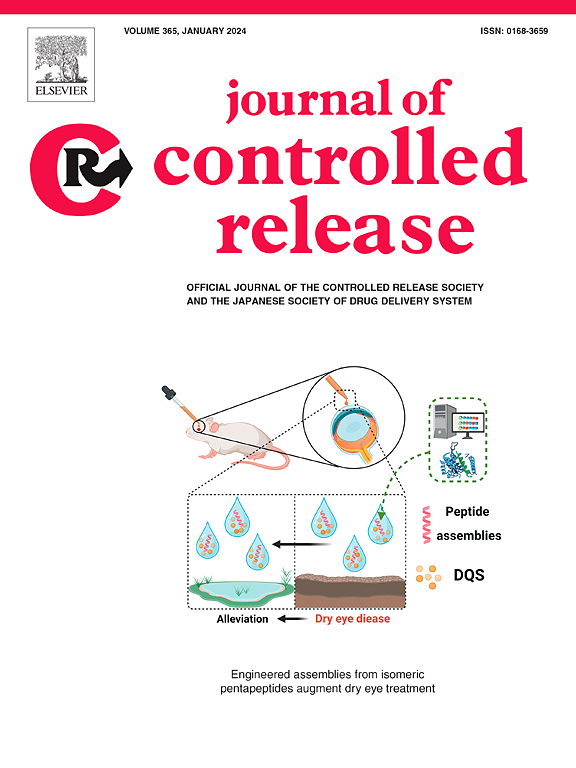Leech bionic Hirudin fusion protein prodrug loaded microneedles for long-term inhibition of thrombosis
IF 10.5
1区 医学
Q1 CHEMISTRY, MULTIDISCIPLINARY
引用次数: 0
Abstract
The clinical use of anticoagulant drugs for thrombosis is limited by short half-life and bleeding risk, requiring frequent administration and close monitoring. Here, inspired by leech mouthparts, we present a hirudin-based fusion protein prodrug incorporated with microneedles (MNs) for long-term antithrombotic therapy to achieve a simplified dosing regimen, continuous protection, and on-demand antithrombotic bioactivity recovery. Genetic-engineered anticoagulant prodrugs are precisely customized by fusing hirudin to elastin-like polypeptides with adjustable assembly characteristics. The introduction of elastin-like polypeptides can shield the biological activity of hirudin, drive the self-assembly of fusion proteins, and prolong their half-life in vivo. The fusion protein prodrugs circulate in the blood as sentinels and accumulate in the thrombus site with the assistance of the clot-targeted motif. Under the catalysis of FXa during thrombosis, the fusion protein prodrugs adaptively restore anticoagulant activity to inhibit thrombus formation. Notably, the assembled prodrugs were integrated into an MN matrix made of silk fibroin and chitosan through photopolymerization for long-term controlled release and facile self-administration. It was proved that the bionic MNs conveniently provide long protection against thrombosis without increasing bleeding events. These excellent performances indicate that the bionic MN patch has broad application prospects in thrombosis and related diseases.


用于长期抑制血栓形成的水蛭仿生水蛭素融合蛋白原药负载微针
抗凝药物治疗血栓形成的临床应用受到半衰期短和出血风险的限制,需要频繁给药和密切监测。在这里,受水蛭口器的启发,我们提出了一种基于水蛭素的融合蛋白前药与微针(MNs)结合用于长期抗血栓治疗,以实现简化的给药方案,持续的保护,并按需恢复抗血栓生物活性。基因工程抗凝前药是通过将水蛭素与具有可调节组装特性的弹性蛋白样多肽融合而精确定制的。弹性蛋白样多肽的引入可以屏蔽水蛭素的生物活性,驱动融合蛋白的自组装,延长其体内半衰期。融合蛋白前药作为哨兵在血液中循环,并在血栓靶向基序的帮助下积聚在血栓部位。血栓形成过程中,融合蛋白前药在FXa的催化下,自适应恢复抗凝活性,抑制血栓形成。值得注意的是,组装好的前药通过光聚合被整合到由丝素蛋白和壳聚糖组成的MN基质中,具有长期控释和易于自我给药的特点。实验证明,仿生网状膜在不增加出血事件的情况下,方便地提供长时间的血栓保护。这些优异的性能表明仿生MN贴片在血栓及相关疾病方面具有广阔的应用前景。
本文章由计算机程序翻译,如有差异,请以英文原文为准。
求助全文
约1分钟内获得全文
求助全文
来源期刊

Journal of Controlled Release
医学-化学综合
CiteScore
18.50
自引率
5.60%
发文量
700
审稿时长
39 days
期刊介绍:
The Journal of Controlled Release (JCR) proudly serves as the Official Journal of the Controlled Release Society and the Japan Society of Drug Delivery System.
Dedicated to the broad field of delivery science and technology, JCR publishes high-quality research articles covering drug delivery systems and all facets of formulations. This includes the physicochemical and biological properties of drugs, design and characterization of dosage forms, release mechanisms, in vivo testing, and formulation research and development across pharmaceutical, diagnostic, agricultural, environmental, cosmetic, and food industries.
Priority is given to manuscripts that contribute to the fundamental understanding of principles or demonstrate the advantages of novel technologies in terms of safety and efficacy over current clinical standards. JCR strives to be a leading platform for advancements in delivery science and technology.
 求助内容:
求助内容: 应助结果提醒方式:
应助结果提醒方式:


